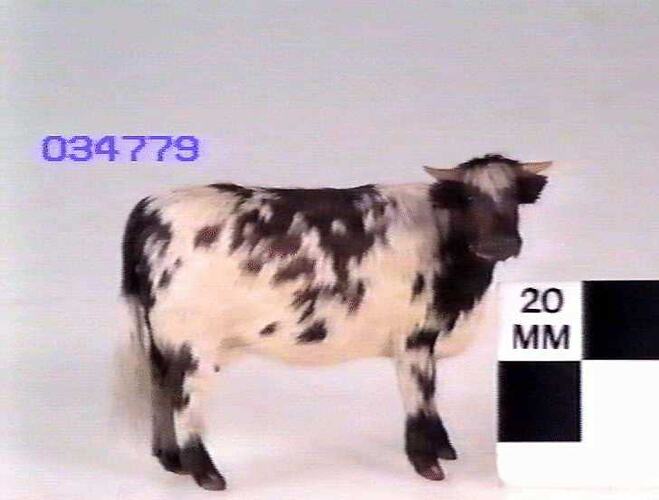Summary
Model cow. Possibly Ayrshire breed or Ayrshire Cross.
Model made by Mrs. Mary Jane Penrose-Johnston (nee Gore) of Armidale, New South Wales, (born 8 June 1858, died 25 August 1944). Mrs Penrose-Johnston began model making with her two sisters Martha and Wilhelmina during their childhood. Martha married Gustave Drabsch in 1878, and Whilhelmina married John Jurd in 1886. Mary Jane Penrose-Johnston first exhibited in 1879 at the Sydney Exhibition, receiving a "Highly Commended" for the beeswax models of four cows. Mrs Penrose Johnston continued to make the model animals until she was an old lady - 'her great-great-granddaughter remembers her working at the models by lamplight, even in the last five years of her life'.
Extract from the Dictionary of Australian Artists Online:
"The sisters exhibited model cows in a number of international exhibitions: at Sydney in 1879, at the Melbourne Centennial International in 1888, probably at the 1886 Colonial and Indian, London, at the 1888 Glasgow International and at the 1893 World's Columbian Exposition in Chicago. They were Highly Commended by the judges of the Ladies' Court at the Sydney International Exhibition who noted kindly, 'the modelling shows a great deal of natural talent, worthy of encouragement'. Similarly recognised by the Sydney Morning Herald, they were rather romantically described as 'the untaught daughters of a shepherd'. They also entered model cows in local shows, such as the Exhibition of Women's Industries in Sydney in 1888 and that held by the National Agricultural and Industrial Association of Queensland in 1912. Examples of models by Mary Jane Gore and her sisters are to be found among the families and friends of their descendents in New England, in the Powerwhouse Museum and at Saumarez, near Armidale." [Source: http://www.daao.org.au/main/read/2848]
Physical Description
The model consists of a paper mache armature, shaped with bees wax, and brown and white coat consisting of cow hair. The eyes are probably made of glass, with ears, and udders & hooves of wood. Horns are made from real horn whittled down to size. Scale approx. 1:20. [To be confirmed]
Significance
In the 1879 Sydney Exhibition, three sisters from Armidale, New South Wales, Mary, Martha and Wilhemina Gore, were highly commended for their beeswax models of four cows. This was the first public display of what became for Mary Gore (later Mrs Penrose Johnston, 1858 - 1944) a lifetime hobby.
Mary Jane Gore was born in 1858 and married James Johnston, a dairy farmer from Armidale. She developed a technique of making miniature farm animals, first using a clay core, wrapping it with brown paper, then adding a beeswax surface which was soft and easily modelled. Ears and horns, doll's eyes and the fur or fleece were added later. The accurate patterns on the cow's hide were made using tweezers, applying several hairs at a time. She received an Honourable Mention in the Centennial International Exhibition in Melbourne, 1888, for a model of a cow; and she won First Prize at the Brisbane Show in 1912 for her 'Miniature Cattle Ranch'.
Mrs Penrose Johnston continued to make the model animals until she was an old lady - 'her great-great-granddaughter remembers her working at the models by lamplight, even in the last five years of her life'.
More Information
-
Collecting Areas
-
Acquisition Information
Donation from Mrs Elizabeth A. Fry, 09 Dec 1969
-
Modelmaker
Mrs Mary J. Penrose Johnston, Armidale, New South Wales, Australia, 1879-1944
Mrs Penrose began model making with her two sisters and first exhibited in 1879 at the Sydney Exhibition, receiving a "Highly Commended" for the beeswax models of four cows. She continued model making until her death in 1944. -
Classification
-
Category
-
Discipline
-
Type of item
-
Overall Dimensions
90 mm (Length), 40 mm (Width), 70 mm (Height)
-
References
Jennifer Isaacs: 'The Gentle Arts: 200 years of Australian women's domestic and decorative arts', p.200 - 201.
-
Keywords
